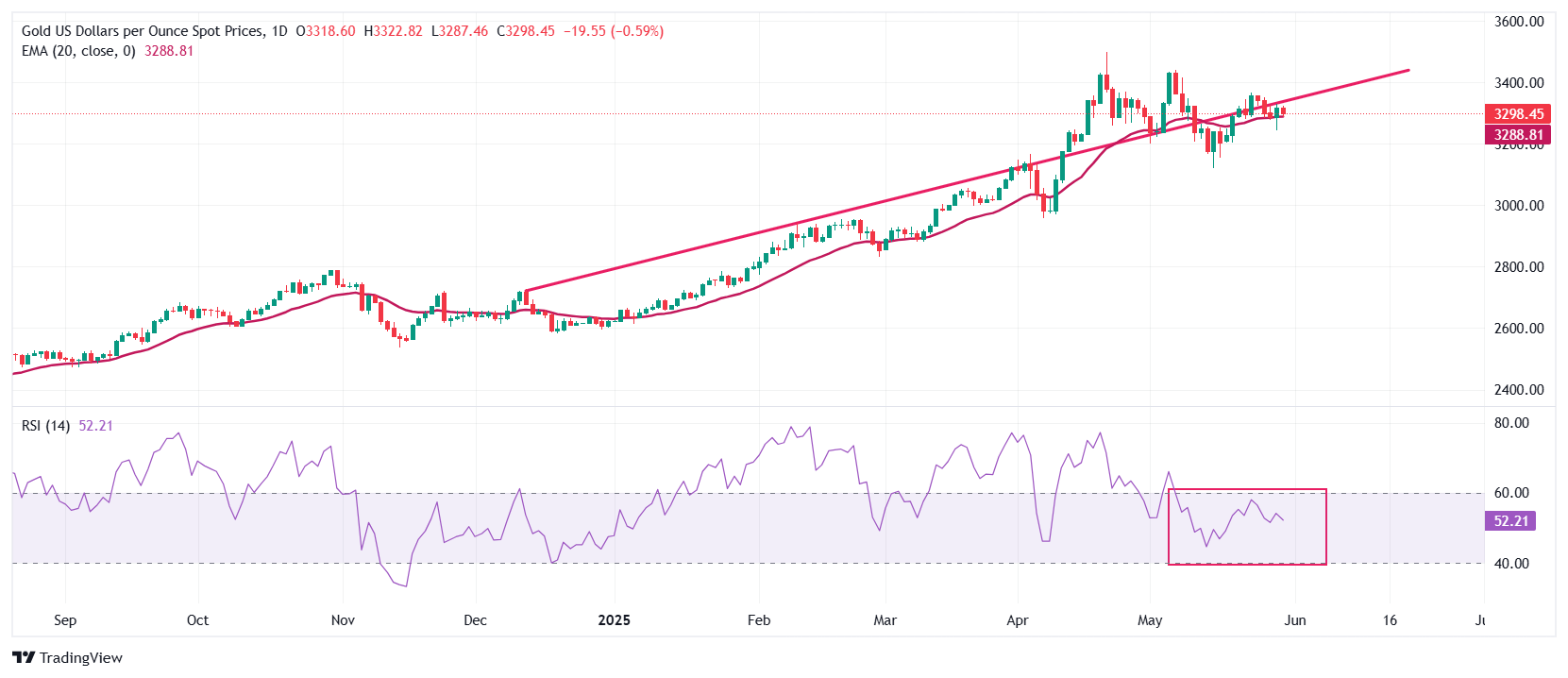Gold declines as US Dollar rebounds after Appeals court suspends tariff ban
- Gold price falls back to near $3,300 as the US Dollar rebounds after US Appeals court lifts the ban on Trump’s tariffs temporarily.
- Earlier, US International Trade court struck down Trump’s tariffs as they were implemented under the cover of a national emergency.
- The US core PCE inflation is expected to grow moderately by 2.5% on year in April.
Gold price (XAU/USD) slides to near $3,290 during European trading hours on Friday, following a strong upside move the previous day. The yellow metal faces selling pressure as the US Dollar (USD) gains ground after the United States (US) Court of Appeals suspends the federal trade court’s decision to ban the majority of tariffs announced by President Donald Trump, potentially diminishing hopes of permanent invalidation of import duties.
Typically, a higher US Dollar makes investment in the Gold price an expensive bet for investors. At the time of writing, the US Dollar Index (DXY), which tracks the Greenback’s value against six major currencies, bounces back to near 99.65.
On Wednesday, the US court of International Trade quoted most of the tariffs announced by Trump as “illegal”, citing that large trade imbalances don’t constitute a “national emergency” under the International Emergency Economic Powers Act (IEEPA).
Using the IEEPA law, Trump announced reciprocal tariffs on all of his trading partners, a fentanyl duty on China, Canada and Mexico, and border negligence levies on his North American peers.
Daily digest marker movers: Gold price trades lower ahead of US PCE Inflation data
- A slight corrective move in the Gold price is also driven by anxiety among financial market participants ahead of the US Personal Consumption Expenditure Price Index (PCE) data for April, which will be published at 14:30 GMT.
- The core US PCE inflation data, which is the Federal Reserve’s (Fed) preferred inflation gauge, is expected to have grown at a moderate pace of 2.5% on year, compared to the prior release of 2.6%. On a monthly basis, the underlying inflation data is expected to have grown by 0.1% after remaining flat in March.
- However, the impact of the US PCE inflation data is likely to be limited in shaping market views on the Federal Reserve’s (Fed) monetary policy outlook, as officials are more concerned about consumer inflation expectations amid uncertainty over Trump’s tariff policy.
- On Thursday, Chicago Fed Bank President Austan Goolsbee stated that elevated uncertainty surrounding Trump’s tariff policy has held back US business. "If people can’t count on consistent policy, then they’re just going to slow down and not act," Goolsbee said, Reuters reported. Regarding the court ruling against the tariff policy, he added that the uncertainty would increase if the administration goes the other way to keep import duties in existence. Goolsbee also signaled that policymakers could bring interest rates down if “tariffs are avoided by a deal or otherwise”.
- The White House stated on Thursday that it will manage to keep tariffs in any way. “You can assume that even if we lose [in court], we will do it [tariffs] another way,” Washington trade negotiator Peter Navarro said, Reuters reported.
Technical Analysis: Gold price wobbles around 20-day EMA

Gold price continues to struggle near the upward-sloping trendline on a daily timeframe around $3,335, which is plotted from the December 12 high of $2,726. The near-term trend of the precious metal is uncertain as it wobbles around the 20-day Exponential Moving Average (EMA), which trades near $3,290.
The 14-day Relative Strength Index (RSI) oscillates inside the 40.00-60.00 range, suggesting indecisiveness among market participants.
Looking up, the May 7 high around $3,440 will act as key resistance for the metal. On the downside, the May 15 low at $3,120 will be the key support zone.
Gold FAQs
Gold has played a key role in human’s history as it has been widely used as a store of value and medium of exchange. Currently, apart from its shine and usage for jewelry, the precious metal is widely seen as a safe-haven asset, meaning that it is considered a good investment during turbulent times. Gold is also widely seen as a hedge against inflation and against depreciating currencies as it doesn’t rely on any specific issuer or government.
Central banks are the biggest Gold holders. In their aim to support their currencies in turbulent times, central banks tend to diversify their reserves and buy Gold to improve the perceived strength of the economy and the currency. High Gold reserves can be a source of trust for a country’s solvency. Central banks added 1,136 tonnes of Gold worth around $70 billion to their reserves in 2022, according to data from the World Gold Council. This is the highest yearly purchase since records began. Central banks from emerging economies such as China, India and Turkey are quickly increasing their Gold reserves.
Gold has an inverse correlation with the US Dollar and US Treasuries, which are both major reserve and safe-haven assets. When the Dollar depreciates, Gold tends to rise, enabling investors and central banks to diversify their assets in turbulent times. Gold is also inversely correlated with risk assets. A rally in the stock market tends to weaken Gold price, while sell-offs in riskier markets tend to favor the precious metal.
The price can move due to a wide range of factors. Geopolitical instability or fears of a deep recession can quickly make Gold price escalate due to its safe-haven status. As a yield-less asset, Gold tends to rise with lower interest rates, while higher cost of money usually weighs down on the yellow metal. Still, most moves depend on how the US Dollar (USD) behaves as the asset is priced in dollars (XAU/USD). A strong Dollar tends to keep the price of Gold controlled, whereas a weaker Dollar is likely to push Gold prices up.

